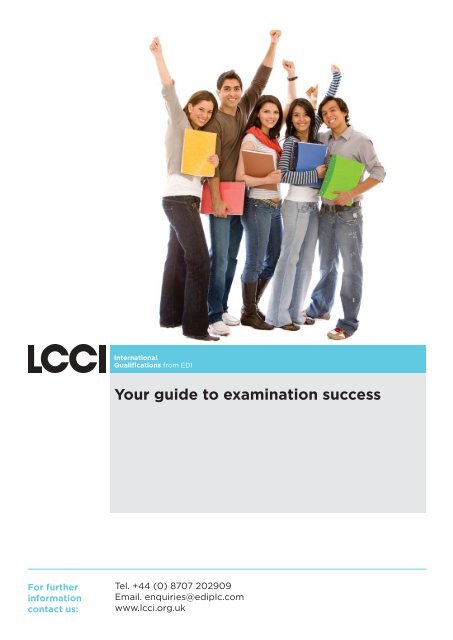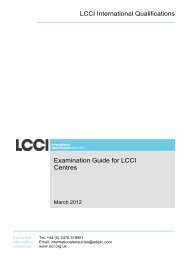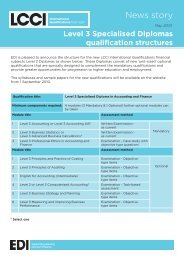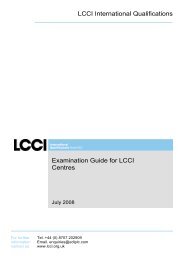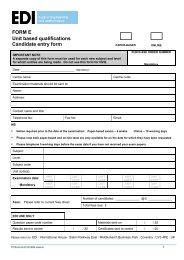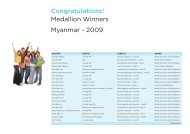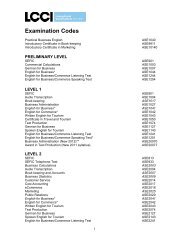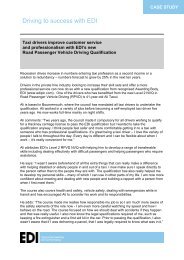Guide to Examination Success - LCCI International Qualifications
Guide to Examination Success - LCCI International Qualifications
Guide to Examination Success - LCCI International Qualifications
Create successful ePaper yourself
Turn your PDF publications into a flip-book with our unique Google optimized e-Paper software.
Your guide <strong>to</strong> examination success<br />
For further<br />
information<br />
contact us:<br />
Tel. +44 (0) 8707 202909<br />
Email. enquiries@ediplc.com<br />
www.lcci.org.uk
How <strong>to</strong> answer exam questions<br />
There isn't<br />
a 'knack' <strong>to</strong><br />
examination<br />
success. It's a<br />
combination<br />
of hard work,<br />
preparation,<br />
and clear<br />
thinking.<br />
If you were <strong>to</strong> ask an examiner the most common reason why some students do<br />
poorly on exams, it is likely that he/she would say that “students just don’t answer the<br />
question”. While there are different ways of ‘not answering the question’, it is more<br />
often the case that students misinterpret the command words in the exam questions.<br />
Every exam question will use one or more command words. These command words tell<br />
you what the examiner is asking you <strong>to</strong> do and give you guidance on how you should<br />
answer the question. If the question has two command words, this means that you<br />
are being asked <strong>to</strong> do two specific things; if you only respond <strong>to</strong> one command word<br />
then you would not be awarded full marks as the marks available would have been split<br />
between the two things that are required in order <strong>to</strong> answer it.<br />
Below is a list of command words along with the approach that you should take when<br />
answering exam questions that use these words. Having a good understanding of how<br />
<strong>to</strong> answer questions based on the command word will certainly help you <strong>to</strong> avoid falling<br />
in<strong>to</strong> the trap of not answering the question.<br />
List<br />
State<br />
Give<br />
Very basic skill – asking you <strong>to</strong> simply remember items and write them in the form of a<br />
list – no need <strong>to</strong> go in detail.<br />
Not difficult - just write what you are asked about in a clear, simple and ‘<strong>to</strong> the point’<br />
way; no need <strong>to</strong> explain or clarify, unless you think that what you’ve written isn’t clear.<br />
Very straight forward – just outline your points briefly.<br />
Outline<br />
Just give the main features or general idea.<br />
Define<br />
Describe<br />
Distinguish<br />
Explain<br />
Identify<br />
Illustrate<br />
Apply<br />
This mainly tests your memory. Here you need <strong>to</strong> give the specific meaning of words,<br />
terms, etc.; it may be the definition from a textbook or you could use your own words.<br />
You just need <strong>to</strong> tell what it is - imagine and give information that paints a complete<br />
picture. Think of it as the next step on from ‘list’ or ‘state’.<br />
You can only distinguish between things, so there needs <strong>to</strong> be two or more things given<br />
in the question. The key is only <strong>to</strong> write about the features of each of the things that<br />
make them different from each other.<br />
Not a difficult one but students sometimes give a description instead of explain. When<br />
you’re asked <strong>to</strong> explain something, use a paragraph: write a sentence that makes<br />
your point, and then write another <strong>to</strong> explain why the first sentence is so, or the<br />
consequences of the first sentence. If your point still isn’t clear, write a third sentence<br />
that makes it clearer. Use examples <strong>to</strong> help your explanations.<br />
This requires a selective use of your knowledge; this means that you apply bits of your<br />
knowledge <strong>to</strong> the context or the situation described in the question.<br />
Fairly easy – just clarify or explain using examples. If there’s a scenario, give a relevant<br />
example. If not, pick whichever you like. Depending on the subject you could draw a<br />
diagram or do a quick calculation as a way of illustrating.<br />
Asking you <strong>to</strong> put something <strong>to</strong> practical use; not just talking about the theory but<br />
showing how the theory works in practice.<br />
www.lcci.org.uk
Calculate/<br />
Compute<br />
Just as it says – you have <strong>to</strong> do the maths.<br />
Demonstrate/<br />
Show<br />
Prepare<br />
Analyse<br />
Examine<br />
Classify<br />
Compare<br />
and Contrast<br />
Summarise<br />
Discuss<br />
Review<br />
Interpret<br />
Evaluate/<br />
Assess<br />
Suggest/<br />
Recommend<br />
You need <strong>to</strong> show or prove something <strong>to</strong> be true, beyond any doubt, or show that it<br />
applies in the situation described, by giving evidence.<br />
Mostly used in book-keeping and accounting - when this verb is used, there is a fair<br />
amount of data (often numerical) in the question. You need <strong>to</strong> take the relevant data,<br />
process it (perhaps by calculation, but often just by rearranging it), then provide it in a<br />
particular format; for example, preparing a balance sheet from the trial balance.<br />
This is one of the more difficult words. This is asking you <strong>to</strong> examine something in<br />
detail; break it down in<strong>to</strong> smaller parts and give detailed explanations with examples if<br />
appropriate; often opinions rather than facts.<br />
Inspect carefully or look at in detail; investigate.<br />
This is asking you <strong>to</strong> arrange or put things in<strong>to</strong> groups or classes. You will need <strong>to</strong><br />
explain why you have put each in a particular list and not one of the others.<br />
Explaining how things are similar and how they are different (similarities and<br />
differences). For example, compare and contrast a pig and a dog – they both have four<br />
legs (similarity) but one barks and the other grunts (difference).<br />
Giving the important ideas in brief.<br />
This can be a tricky one. In order <strong>to</strong> discuss something, there needs <strong>to</strong> be an ‘argument’<br />
i.e, you need two or more differing or opposing viewpoints. Also, any discussion<br />
should, if possible, end with a conclusion. Think about: advantages, disadvantages,<br />
and conclusion. Or: reasons why, reasons why not and conclusion. It is also possible<br />
<strong>to</strong> ‘discuss’ one viewpoint. For example you may be asked <strong>to</strong> ‘discuss the advantages<br />
of…’. Does this mean you have <strong>to</strong> do the disadvantages as well? No - simply go through<br />
the advantages, saying whether they apply in this situation, or whether they are each a<br />
major advantage or a relatively minor one.<br />
Giving an overview of ideas and establishing their qualities and features.<br />
Can be challenging - you need <strong>to</strong> explain your view of facts and ideas and how they<br />
relate <strong>to</strong> one another. In some sense, translating from one form of words <strong>to</strong> another.<br />
‘Interpret’ is often the second stage of ‘analyse’.<br />
Another tricky one – this is asking you <strong>to</strong> judge the worth, importance or value of<br />
something, whether in monetary terms or not. Think of this as a higher level discussion.<br />
As it says – telling them what <strong>to</strong> do. This is normally the last requirement in a question<br />
because you first need <strong>to</strong> identify, explain and evaluate before you can recommend or<br />
suggest a way forward.<br />
Practical exam tips on the next page...<br />
www.lcci.org.uk<br />
www.lcci.org.uk
Practical exam tips<br />
Revision<br />
Revision is important for examination success. There are different techniques <strong>to</strong> help<br />
you revise – mind maps, acronyms, flash cards, etc – find the technique that works for<br />
you. Don’t forget <strong>to</strong> use past and sample papers – however, don’t fall in<strong>to</strong> the trap of<br />
revising only what has been tested before.<br />
Before the<br />
exam<br />
The night<br />
before<br />
Arriving at<br />
the exam<br />
room<br />
The exam<br />
paper<br />
Question<br />
timing<br />
Obey the<br />
examination<br />
rules<br />
Check your<br />
answers<br />
General tips<br />
Make sure that you are properly registered for the exam. Check the time, date and place<br />
of the exam. If you are not sure of location, visit before the date of the exam.<br />
Have an early night – don’t try <strong>to</strong> study any completely new material; instead use the<br />
time for a general overview. Gather the things you will need for the next day – don’t<br />
forget your ID if this is a requirement in your country!<br />
Get <strong>to</strong> the location on time. Settle in as quickly as possible and avoid distractions and<br />
have all the necessary <strong>to</strong>ols ready.<br />
Check the instructions and directions on the exam paper – confirm that the format is<br />
what you expect. Read the entire paper and identify the questions you prefer <strong>to</strong> answer,<br />
if you are given a choice. Put an ‘X’ against those you prefer not <strong>to</strong> answer or cannot<br />
answer. Quickly write down ideas for answers as they come <strong>to</strong> you so you don’t forget<br />
them later.<br />
When deciding which questions <strong>to</strong> do first, it is better <strong>to</strong> start with your favourite <strong>to</strong>pic<br />
– this will make you more confident. However, if you prefer, you may start with the more<br />
difficult question and save your favourite for later – go with what works best for you.<br />
Plan how long you will spend on a question based on the number of questions you need<br />
<strong>to</strong> complete and the <strong>to</strong>tal examination time and keep checking on this. Don’t spend <strong>to</strong>o<br />
long on multiple choice questions – if you cannot answer the question come back <strong>to</strong> it<br />
later and have a guess if you really don’t know.<br />
Never omit an entire question – no matter how well you answer other questions,<br />
you must leave time for all questions. If you write nothing, you cannot be awarded<br />
any marks for that question – writing something may at least give you a few marks.<br />
Remember your command words – do not waste time writing what isn’t necessary!<br />
These will be read <strong>to</strong> you before the examination starts. Follow all instructions for<br />
completing the front cover of your booklet.<br />
Spend the last few minutes checking your answers for any mistakes and any omissions.<br />
Write as clearly as possible – the examiner will be pleased if your script is well written<br />
and easy <strong>to</strong> understand. If you have <strong>to</strong> correct answers do it neatly. Don’t look for<br />
‘hidden traps’ that don’t exist – the examiner is not trying <strong>to</strong> trick you! All the examiner<br />
wants you <strong>to</strong> do is ‘just answer the question’!<br />
All the best!<br />
<strong>LCCI</strong>/examsuccess/0809<br />
EDI | <strong>International</strong> House | Siskin Parkway East | Middlemarch Business Park | Coventry | CV3 4PE | UK<br />
Tel. +44 (0) 8707 202909 | Fax. +44 (0) 2476 516505 | Email. enquiries@ediplc.com | www.ediplc.com


